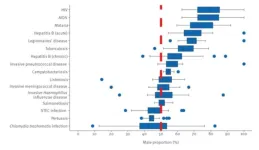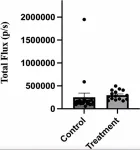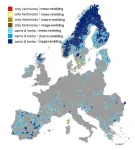(Press-News.org) A study published in Eurosurveillance analysing 5.5 million cases of infectious diseases in the European Union/European Economic Area (EU/EEA) over 10 years has found important differences in the relative proportion of notified male versus female cases for several diseases. The proportion of males ranged on average from 40-45% for pertussis and Shiga toxin-producing Escherischia coli (STEC) infections to 75-80% for HIV/AIDS.
“Although this study was not able to fully explain the differences observed across countries and diseases, it offers some interesting leads,” said Julien Beauté, principal expert in general surveillance at the European Centre for Disease Prevention and Control (ECDC) and co-author of the study.
“Based on possible explanation(s) for these differences, public health professionals should further investigate whether this could apply to their setting to eventually design sex-specific interventions for infectious disease prevention and control.”
Methodology
Researchers conducted a retrospective analysis of surveillance data on cases reported between 2012 and 2021 for 16 infectious diseases notifiable at the EU level, and included data from 30 countries.
“Surveillance data at EU/EEA level provide a unique opportunity to compare epidemiological patterns and testing or screening policies across countries,” said Julien Beauté.
The study recorded male proportions of cases for each disease, which were also computed by country, year and six age groups (< 5, 5–14, 15–24, 25–44, 45–64, and ≥ 65 years). The number of reporting countries ranged from 24 (Chlamydia trachomatis infection and hepatitis B) to 30 (HIV/AIDS, invasive Haemophilus influenzae disease, Legionnaires’ disease and tuberculosis). Cases reported with sex recorded as ‘other’ were excluded.
Results
For campylobacteriosis, acute hepatitis B, Legionnaires’ disease, malaria and HIV/AIDS, the male proportion was above 50% in all countries. Only two diseases, pertussis and STEC infection, had a male proportion below 50% in most countries.
The proportion of males did not vary significantly between most countries, which could indicate common drivers for sex differences across countries. Most outliers were countries reporting few cases. Country-specific screening policies could also explain male proportions observed in countries that diverged from the EU/EEA average.
Possible sex- and gender-related factors and public health implications
The role of biological sex and gender in the transmission of infectious diseases is complex, and depends on context and disease. While the study could not completely explain the sex differences observed in the data, it did provide some insights.
Some STIs and blood-borne diseases such as HIV and hepatitis B had a higher proportion of male cases, likely reflecting the higher risk of infection associated with certain modes of transmission. The higher male proportion for malaria could be due to higher exposure in males, with one previous study suggesting women are less likely to be infected by vector-borne diseases.
Other differences could be related to risk and testing. For example, the lower proportion of males with C. trachomatis infections was mostly explained by testing policies, as chlamydia prevalence is likely to be similar in both sexes, but screening programmes often target sexually active young women.
Findings underscored the relevance of characteristics of surveillance systems in interpreting data. Julien Beauté said:
“The study highlighted the importance of documenting some key characteristics of surveillance systems or variables to help interpret surveillance data, including case detection policy (e.g. screening of asymptomatic people), variables related to a specific setting of infection (e.g. travel, occupation) or mode of transmission (e.g. sex between men), that may drive a sex difference, and information on both sex and gender for some diseases such as sexually-transmitted infections.”
These would help better identify differences related to sex and gender, which would then inform and improve the design of targeted public health interventions.
END
Study highlights sex differences in notified infectious disease cases across Europe
A study analysing 5.5 million cases of infectious diseases in the EU/EEA over 10 years has found important differences in the relative proportion of notified male versus female cases for several diseases.
2024-08-15
ELSE PRESS RELEASES FROM THIS DATE:
Nanobody inhibits metastasis of breast tumor cells to lung in mice
2024-08-15
“In the present study we describe the development of an inhibitory nanobody directed against an extracellular epitope present in the native V-ATPase c subunit.”
BUFFALO, NY- August 15, 2024 – A new research paper was published in Oncotarget's Volume 15 on August 14, 2024, entitled, “A nanobody against the V-ATPase c subunit inhibits metastasis of 4T1-12B breast tumor cells to lung in mice.”
The vacuolar H+-ATPase (V-ATPase) is an ATP-dependent proton pump that functions to control the pH of intracellular compartments ...
Detecting machine-generated text: An arms race with the advancements of large language models
2024-08-15
Machine-generated text has been fooling humans for the last four years. Since the release of GPT-2 in 2019, large language model (LLM) tools have gotten progressively better at crafting stories, news articles, student essays and more, to the point that humans are often unable to recognize when they are reading text produced by an algorithm. While these LLMs are being used to save time and even boost creativity in ideating and writing, their power can lead to misuse and harmful outcomes, which are already ...
Nearly 25% of European landscape could be rewilded
2024-08-15
Europe's abandoned farmlands could find new life through rewilding, a movement to restore ravaged landscapes to their wilderness before human intervention. A quarter of the European continent, 117 million hectares, is primed with rewilding opportunities, researchers report August 15 in the Cell Press journal Current Biology. They provide a roadmap for countries to meet the 2030 European Biodiversity Strategy's goals to protect 30% of land, with 10% of those areas strictly under conservation.
The team ...
Emergency departments could help reduce youth suicide risk
2024-08-15
A study of over 15,000 youth with self-inflicted injury treated in Emergency Departments (EDs) found that around 25 percent were seen in the ED within 90 days before or 90 days after injury, pointing to an opportunity for ED-based interventions, such as suicide risk screening, safety planning, and linkage to services. Nearly half of ED visits after the self-inflicted injury encounter were for mental health issues.
“Self-inflicted injury is an important predictor of suicide risk,” said Samaa Kemal, MD, MPH, emergency medicine physician at Ann & Robert H. Lurie ...
Uterus transplant in women with absolute uterine-factor infertility
2024-08-15
About The Study: Uterus transplant was technically feasible and was associated with a high live birth rate following successful graft survival. Adverse events were common, with medical and surgical risks affecting recipients as well as donors. Congenital abnormalities and developmental delays have not occurred to date in the live-born children.
Corresponding Author: To contact the corresponding author, Liza Johannesson, MD, PhD, email Liza.Johannesson@bswhealth.org.
To access the embargoed study: Visit our For The Media website at this link https://media.jamanetwork.com/
(doi:10.1001/jama.2024.11679)
Editor’s ...
Adverse childhood experiences and adult household firearm ownership
2024-08-15
About The Study: Consistent with prior research on adverse childhood experience (ACE; defined as abuse, neglect, and household dysfunction before age 18) exposure and presence of a firearm in the household during childhood, this study found that cumulative ACE exposure was associated with higher odds of household firearm ownership in adulthood. The relationship may be due to a heightened sense of vulnerability to physical violence and greater perceived threats to personal safety associated with a traumatic childhood, which lead individuals to seek self-protection.
Corresponding Author: To contact the corresponding author, Alexander Testa, PhD, email alexander.testa@uth.tmc.edu.
To ...
Warning signs: National data indicate that autistic birthing people are at increased risk for postpartum anxiety and depression
2024-08-15
American women have the highest rate of maternal deaths among high-income countries, with outcomes worse for minoritized groups. In an effort to understand the maternal health of pregnant people with intellectual and developmental disabilities, including autism and intellectual disability, researchers from Drexel University’s Policy and Analytics Center in the A.J. Drexel Autism Institute examined Medicaid data to identify perinatal and postpartum outcomes among people with intellectual and developmental disabilities. The study was recently published in JAMA Network Open.
“While ...
Can a mouthwash-based test help predict head and neck cancer recurrence?
2024-08-15
MIAMI, FLORIDA (EMBARGOED UNTIL AUG. 15, 2024 @ 11 A.M. EDT) – For years, mouthwash has been marketed as an essential hygiene item to prevent bad breath, even though it offers minimal if any health benefits.
But what if a mouthwash-based test to detect biomarkers can help physicians predict disease recurrence in head and neck cancer patients?
That futuristic scenario seems closer to reality after a new study by researchers at Sylvester Comprehensive Cancer Center at the University of Miami Miller School of Medicine, UC San Diego Health and collaborating cancer centers.
Their findings, ...
University of Michigan School of Public Health department renamed Health Behavior & Health Equity, reflecting longstanding commitment to health equity
2024-08-15
The Department of Health Behavior & Health Education at the University of Michigan School of Public Health will become the Department of Health Behavior & Health Equity, effective August 15, 2024. The new name reflects the department’s increasing focus on issues of health equity in research, teaching and service.
“Health equity is at the core of our mission and actions in public health,” said F. DuBois Bowman, dean of Michigan Public Health. “I am grateful to the many members of the Health Behavior & Health Equity community ...
New microscope offers faster, high-resolution brain imaging
2024-08-15
WASHINGTON — Researchers have developed a new two-photon fluorescence microscope that captures high-speed images of neural activity at cellular resolution. By imaging much faster and with less harm to brain tissue than traditional two-photon microscopy, the new approach could provide a clearer view of how neurons communicate in real time, leading to new insights into brain function and neurological diseases.
“Our new microscope is ideally suited for studying the dynamics of neural networks in real time, which is crucial for understanding fundamental brain functions such as learning, memory and decision-making,” said research team leader ...
LAST 30 PRESS RELEASES:
Heart-brain connection: international study reveals the role of the vagus nerve in keeping the heart young
Researchers identify Rb1 as a predictive biomarker for a new therapeutic strategy in some breast cancers
Survey reveals ethical gaps slowing AI adoption in pediatric surgery
Stimulant ADHD medications work differently than thought
AI overestimates how smart people are, according to HSE economists
HSE researchers create genome-wide map of quadruplexes
Scientists boost cell "powerhouses" to burn more calories
Automatic label checking: The missing step in making reliable medical AI
Low daily alcohol intake linked to 50% heightened mouth cancer risk in India
American Meteorological Society announces Rick Spinrad as 2026 President-Elect
Biomass-based carbon capture spotlighted in newly released global climate webinar recording
Illuminating invisible nano pollutants: advanced bioimaging tracks the full journey of emerging nanoscale contaminants in living systems
How does age affect recovery from spinal cord injury?
Novel AI tool offers prognosis for patients with head and neck cancer
Fathers’ microplastic exposure tied to their children’s metabolic problems
Research validates laboratory model for studying high-grade serous ovarian cancer
SIR 2026 delivers transformative breakthroughs in minimally invasive medicine to improve patient care
Stem Cell Reports most downloaded papers of 2025 highlight the breadth and impact of stem cell research
Oxford-led study estimates NHS spends around 3% of its primary and secondary care budget on the health impacts of heat and cold in England
A researcher’s long quest leads to a smart composite breakthrough
Urban wild bees act as “microbial sensors” of city health.
New study finds where you live affects recovery after a hip fracture
Forecasting the impact of fully automated vehicle adoption on US road traffic injuries
Alcohol-related hospitalizations from 2016 to 2022
Semaglutide and hospitalizations in patients with obesity and established cardiovascular disease
Researchers ‘listen in’ to embryo-mother interactions during implantation using a culture system replicating the womb lining
How changing your diet could help save the world
How to make AI truly scalable and reliable for real-time traffic assignment?
Beyond fragmented markets: A new framework for efficient and stable ride-pooling
Can shape priors make road perception more reliable for autonomous driving?
[Press-News.org] Study highlights sex differences in notified infectious disease cases across EuropeA study analysing 5.5 million cases of infectious diseases in the EU/EEA over 10 years has found important differences in the relative proportion of notified male versus female cases for several diseases.





